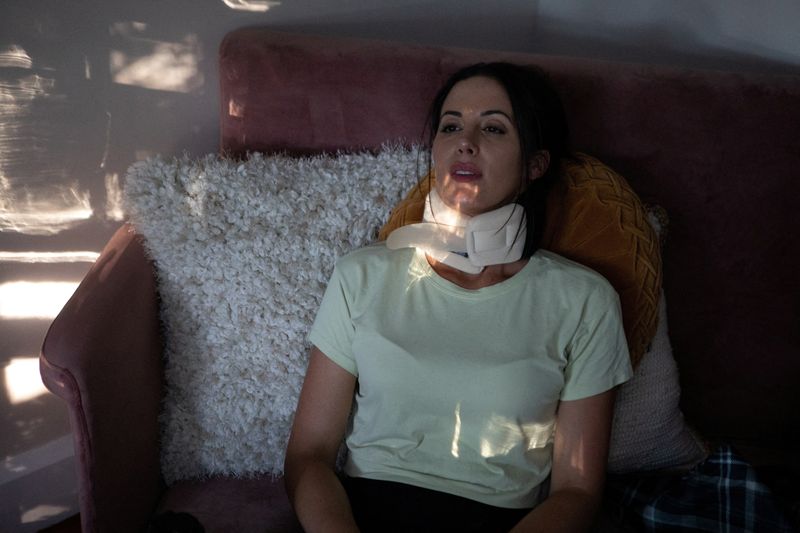Addiction drug shows promise lifting long COVID brain fog, fatigue
2022.10.18 18:30
[ad_1]
3/3

© Reuters. FILE PHOTO: Lauren Nichols, who has long COVID, takes a break and rests in a lounge bed in the office in her home in Andover, Massachusetts, U.S., August 3, 2022. REUTERS/Lauren Owens Lambert/File Photo
2/3
By Julie Steenhuysen
CHICAGO (Reuters) – Lauren Nichols, a 34-year-old logistics expert for the U.S. Department of Transportation in Boston, has been suffering from impaired thinking and focus, fatigue, seizures, headache and pain since her COVID-19 infection in the spring of 2020.
Last June, her doctor suggested low doses of naltrexone, a generic drug typically used to treat alcohol and opioid addiction. After more than two years of living in “a thick, foggy cloud,” she said, “I can actually think clearly.” Researchers chasing long COVID cures are eager to learn whether the drug can offer similar benefits to millions suffering from pain, fatigue and brain fog months after a coronavirus infection. The drug has been used with some success to treat a similar complex, post-infectious syndrome marked by cognitive deficits and overwhelming fatigue called myalgic encephalomyelitis/chronic fatigue syndrome (ME/CFS). Drawing on its use in ME/CFS and a handful of long COVID pilot studies, there are now at least four clinical trials planned to test naltrexone in hundreds of patients with long COVID, according to a Reuters review of Clinicaltrials.gov and interviews with 12 ME/CFS and long COVID researchers. It is also on the short list of treatments to be tested in the U.S. National Institutes of Health’s $1 billion RECOVER Initiative, which aims to uncover underlying causes and find treatments for long COVID, advisers to the trial told Reuters.
Unlike treatments aimed at addressing specific symptoms caused by COVID damage to organs, such as the lungs, low-dose naltrexone (LDN) may reverse some of the underlying pathology driving symptoms, they said.
Naltrexone has anti-inflammatory properties and has been used at low doses for years to treat conditions such as fibromyalgia, Crohn’s disease and multiple sclerosis, said Dr. Jarred Younger, director of the Neuro-inflammation, Pain and Fatigue Laboratory (NYSE:) at the University of Alabama at Birmingham.
At 50 milligrams – 10 times the low dose – naltrexone is approved to treat opioid and alcohol addiction. Several generic manufacturers sell 50mg pills, but low-dose naltrexone must be purchased through a compounding pharmacy.
Younger, author of a scientific review of the drug as a novel anti-inflammatory, in September submitted a grant application to study LDN for long COVID. “It should be at the top of everyone’s list for clinical trials,” he said.
Still, the drug is unlikely to help all patients with long COVID, a collection of some 200 symptoms ranging from pain and heart palpitations to insomnia and cognitive impairment. One 218-patient ME/CFS study found 74% had improvements in sleep, reduced pain and neurological disturbances.
“It’s not a panacea,” said Jaime Seltzer, a Stanford researcher and head of scientific outreach for the advocacy group MEAction. “These people weren’t cured, but they were helped.”
‘HUMAN AGAIN’ Dr. Jack Lambert, an infectious disease expert at University College Dublin School of Medicine, had used LDN to treat pain and fatigue associated with chronic Lyme disease.
During the pandemic, Lambert recommended LDN to colleagues treating patients with lingering symptoms after bouts of COVID.
It worked so well that he ran a pilot study among 38 long COVID patients. They reported improvements in energy, pain, concentration, insomnia and overall recovery from COVID-19 after two months, according to findings published in July.
Lambert, who is planning a larger trial to confirm those results, said he believes LDN may repair damage of the disease rather than mask its symptoms.
Other planned LDN trials include one by the University of British Columbia in Vancouver and a pilot study by Ann Arbor, Michigan-based startup AgelessRx. That study of 36 volunteers should have results by year-end, said company co-founder Sajad Zalzala. Scientists are still working on explaining the mechanism for how LDN might work. Experiments by Dr. Sonya Marshall-Gradisnik of the National Centre for Neuroimmunology and Emerging Diseases in Australia suggest ME/CFS and long COVID symptoms arise from a significant reduction in function of natural killer cells in the immune system. In laboratory experiments, LDN may have helped restore their normal function, a theory that must still be confirmed. Others believe infections trigger immune cells in the central nervous system called microglia to produce cytokines, inflammatory molecules that cause fatigue and other symptoms associated with ME/CFS and long COVID. Younger believes naltrexone calms these hypersensitized immune cells.
Dr. Zach Porterfield, a virologist at the University of Kentucky who co-chairs a RECOVER task force looking at commonalities with other post-infectious syndromes, said it has recommended LDN be included in RECOVER’s treatment trials. Other therapies under consideration, sources said, were antivirals, such as Pfizer Inc (NYSE:)’s Paxlovid, anti-clotting agents, steroids and nutritional supplements. RECOVER officials said they have received dozens of proposals and could not comment on which drugs will be tested until trials are finalized. Dr. Hector Bonilla, co-director of the Stanford Post-Acute COVID-19 Clinic and a RECOVER adviser, has used LDN in 500 ME/CFS patients, with about half reporting benefits.
He studied LDN in 18 long COVID patients, with 11 showing improvements, and said he believes larger, formal trials could determine whether LDN offers a true benefit. Nichols, a patient adviser to RECOVER, was “ecstatic” when she learned LDN was being considered for the government-funded trials. While LDN has not fixed all her COVID-related problems, Nichols can now work all day without breaks and have a social life at home. “It has made me feel like a human again.”
[ad_2]
Source link








